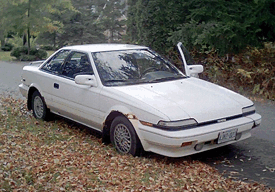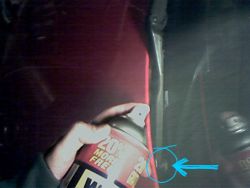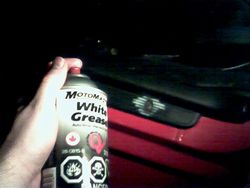 |
|
WINTER STORAGE, THE DEFINITIVE GUIDE - 2004
Step #1 Choosing your storage facility. Best case would be a heated, sealed and vented storage facility under a breathable car cover. NEVER EVER use a plastic tarp to cover the car as it doesn't breath well and will cause paint and rust damage by trapping the moisture against your car. Second best is your own garage under a good, breathable car cover. In this case be sure to place a plastic tarp on the ground between your car and the concrete. Concrete holds a LOT of moisture which will find its way to the underside of your vehicle, you therefor need a vapor barrier. Even a layer of cardboard is better than nothing at all between your ride and the ground. This holds true for dirt floors as well. If you're storing your car on a dirt floor, be sure to sweep away any straw, papers, wrappers, etc. as this makes great nesting material for mice. Worst case is the great outdoors. If you are forced to do this, do NOT put your vehicle under a cover, the wind will move it and wear paint from your vehicles surface. Leave it in the shade if possible and out of harms way. The snow and ice will not harm it and will in fact act as a shield against the wind. Step #2 Change the Oil. This is the MOST
basic step to winter storage. It’s important to remove any Step
#3 Wash the car inside and out. Dirt, dust, salt and
other contaminants left on the body and in the wheel wells
spell bad news
for your vehicle. Clean it thoroughly. Get that six-month old french fry
out from under the seat! You don't want mice moving in looking for a midwinter
snack. Do not wash the car the day you
put it in storage. The car should be washed and driven a couple of days before to get the water out of parts, like inside the doors. It is recommended that a car be driven after every car cash. Once done, spray a little bit of WD 40 into the wiper cavities, and white grease on to all hinges and latches. Coat any scratches or stone chips with a thin coat of vaseline. MAKE SURE THE CAR IS DRY.
Step #4 Your Gas tank.
Fill the gas tank right to the top. Put some "Sta Bil" (the best gas preservative on the market according to the experts) in the tank to stabilize the gas during storage. ("Sta Bil" is available at marine and lawn mower shops as well as Canadian Tire etc. and the amount you need will be explained on the bottle.)
Step #5 Your Tires and Breaks. Some people remove them completely and put the car on blocks or jack-stands. This is of course ideal, but the pro's say not really necessary. Fill your tires to thier suggested pressure and up to 5 lbs extra (to give added support to their sidewalls). Be sure to clean your tires and rims thoroughly as the rubber in the tires is prone to oxidative stress due to road grime and ultraviolet rays from the sun. This oxidation can be seen in the form of a dark yellowish dirt that clings to the sidewalls of the tires. Using a soft brush and soapy water, scrub the tires to remove any built up oxidation and road grime. Once the tires are cleaned and dried, apply a good quality tire dressing. Put your car in gear if possible, rather than using the emergency break, which may stick come spring. Place small blocks in front of and behind the rear wheels to make sure it doesn't decide to roll anywhere until you want it to. Step #6 The Engine. Check your fluids. Check
that your window washer reservoir is full, that you Step #7 The battery.
Step #8 The Interior. Use a good grade of
leather treatment on leather to prevent it from drying out. A) Mothballs: simply put a small plastic cup of mothballs in the vehicle, and a few around the car and in the trunk spaces. The problem with this option is your car WILL smell like mothballs for a good month after coming out of storage in spring. The other option B) is to use a mixture of cinnamon, spearmint, and cloves. Animals generally don't care for the smell of cinnamon and cloves. Insects don't care much for Spearmint and Peppermint. If you do use these, it's best to use the spices whole because they retain their scent better than the crushed ones. Just fill some dixie cups with the spices and place some in the trunk, in the passenger compartment, some under the hood and then sprinkle some around the ground. DO NOT use any kind of poison because the critters will probably eat it and then run into your air cleaner which will stink to high heaven when it gets nice and toasty. Mouse traps are also a bad idea because the food you put into the trap will only attract the vermin. It may catch one, but the remaining food on the trap will attract more critters. Also recommended is to put in some cedar (chips or boards) and silica gel to absorb any excess moisture in the air. Leave your windows cracked open just a TINY amount to allow air flow. Step
#9 Before closing the garage. Make sure that your convertible top is stored UP. Tops such as these will compress over time leaving them deformed if they are in the down position. Cover your car with a car cover, make sure you have blocked the wheels and put the car in gear. Make sure your trickle charger is running properly if you are using one. Wave good-bye. Step #10 Insurance. Check the insurance. Just because a vehicle is sitting undriven does not mean liability coverage is unnecessary. What if someone pushes the car, and it winds up rolling down the driveway and into the neighbor’s brand-new Mercedes? Collision and theft coverage can be important, too. At minimum keep "fire and theft" active on your vehicle. The charge is low and protects you from unforeseen damage. Step #11 During the winter (checkup). Don't forget about your
vehicle over the winter. Periodically check on your vehicle Well that's it. The definitive list for winter storage tips. If you have a comment or want to add your own input please write me at webmaster@trdottawa.com. |
|
 Get
out your beater! Winter is coming, the first snowflakes have fallen, and
the mornings bring frost and the occasional frozen puddle. With a heavy
heart you know it's time to put your baby away until next season. No where
is it as important as here in Canada where our roads can have up to a
foot of snow on them and a good bit of salt under that. It wouldn't do
to watch your ride rust in to its component elements! So what do you do
to protect and store your mechanical child? TRDOttawa.com
has spent hours browsing other websites and magazines to bring you the
definitive list of tips for winter storage:
Get
out your beater! Winter is coming, the first snowflakes have fallen, and
the mornings bring frost and the occasional frozen puddle. With a heavy
heart you know it's time to put your baby away until next season. No where
is it as important as here in Canada where our roads can have up to a
foot of snow on them and a good bit of salt under that. It wouldn't do
to watch your ride rust in to its component elements! So what do you do
to protect and store your mechanical child? TRDOttawa.com
has spent hours browsing other websites and magazines to bring you the
definitive list of tips for winter storage:


 Best
case here is you are able to remove the battery from the car and keep
it stored warm and indoors on a piece of wood or something similar to
catch any errant acids. If you do not wish to remove the battery completely,
disconnect the positive and negative leads, wash the metal nipples with
a mixture of baking soda and water to remove and acidic build up. If you
remove the battery completely, use this mixture to clean off the battery
platform and surrounding area as well. Clean the leads with the same mixture.
It would be best to hook up a trickle charger to the battery, no matter
where you keep it, so that it never looses its charge. The more drained
your battery gets, the shorter its life will be. If you do not wish to
do this then coat the terminals with some dripped wax from a candle. The
wax is easy to remove in spring and does a good job of keeping the rust
away.
Best
case here is you are able to remove the battery from the car and keep
it stored warm and indoors on a piece of wood or something similar to
catch any errant acids. If you do not wish to remove the battery completely,
disconnect the positive and negative leads, wash the metal nipples with
a mixture of baking soda and water to remove and acidic build up. If you
remove the battery completely, use this mixture to clean off the battery
platform and surrounding area as well. Clean the leads with the same mixture.
It would be best to hook up a trickle charger to the battery, no matter
where you keep it, so that it never looses its charge. The more drained
your battery gets, the shorter its life will be. If you do not wish to
do this then coat the terminals with some dripped wax from a candle. The
wax is easy to remove in spring and does a good job of keeping the rust
away. 
